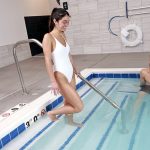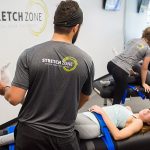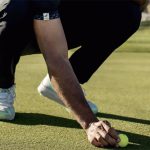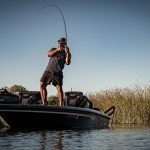The National Federation of State High School Associations (NFHS) has released a detailed list of new rules pertaining to high school football jerseys which will take effect for the 2012-2013 football season.
The new rules were originally approved in 2007, and will be implemented for the first time for the upcoming football season. High schools and uniform manufacturers have had several years to prepare for the new rules and regulations pertaining to home and away uniforms, as well illegal equipment worn by players.
“I don't foresee it to be an issue,” said Bob Colgate, director of sports and sports medicine for the NFHS, in an interview with Team Business. “This isn't something which happened overnight. Our states have done their due diligence, and it's going to be in their hands to make sure that, if there is an issue, it will be addressed.”
A release provided by the NFHS clarifies the new rules. Rule 1-5-1 states that each player must participate while wearing pieces of properly fitted equipment, including the jersey, numbers, and protective pads and equipment, which shall be professionally manufactured and not altered to decrease protection. The jersey must be unaltered from the manufacturer’s original design/production, and will be required to be long enough to reach the top of the pants and shall be tucked in if longer. Players of the visiting team must wear jerseys, unaltered from the manufacturer’s original design/production and meeting the following criteria:
The body of the jersey (inside the shoulders, inclusive of the yoke of the jersey or the shoulders, below the collar, and to the bottom of the jersey) shall be white and shall contain only the listed allowable adornments and accessory patterns in a color(s) that contrasts to white:
(a) as the jersey number(s) required in 1-5-1c or as the team and/or player name within the body and/or on the shoulders,
(b) either as a decorative stripe placed during production that follows the curve of the raglan sleeve or following the shoulder seam in traditional yoke construction, not to exceed 1 inch at any point within the body of the jersey; or as decorative stripe(s) added in the shoulder area after production, not to exceed 1 inch per stripe and total size of combined stripes not to exceed 3.5 inches,
(c) within the collar, a maximum of 1 inch in width, and/or
(d) as a side seam (insert connecting the back of the jersey to the front), a maximum of 4 inches in width but any non-white color may not appear within the body of the jersey (inside the shoulders, inclusive of the yoke of the jersey or the shoulders, below the collar, and to the bottom of the jersey). The exception to (d) would be what is stated in (b) above.
(e) The visiting team is responsible for avoidance of similarity of colors, but if there is doubt, the referee may require players of the home team to change jerseys.
An American flag, not to exceed 2 by 3 inches, and either a commemorative or memorial patch, not to exceed 4 square inches and with written state association approval, may be worn on the jersey provided neither the flag nor the patch interferes with the visibility of the number.
For uniforms worn by players of the home team, jerseys may be worn which are unaltered from the manufacturer’s original design/production and that meet the following criteria: The body of the jersey (inside the shoulders, inclusive of the yoke of the jersey or the shoulders, below the collar, and to the bottom of the jersey) may not include white, except as stated below. If white appears in the body of the jersey of the home team, it may only appear:
(a) as the jersey number(s) required in 1-5-1c or as the team and/or player name within the body and/or on the shoulders,
(b) either as a decorative stripe placed during production that follows the curve of the raglan sleeve or following the shoulder seam in traditional yoke construction, not to exceed 1 inch at any point within the body of the jersey; or as decorative stripe(s) added in the shoulder area after production, not to exceed 1 inch per stripe and total size of combined stripes not to exceed 3.5 inches,
(c) within the collar, a maximum of 1 inch in width, and/or(d) as a side seam (insert connecting the back of the jersey to the front), a maximum of 4 inches in width but any white color may not appear within the body of the jersey (inside the shoulders, inclusive of the yoke of the jersey or the shoulders, below the collar, and to the bottom of the jersey). The exception to (d) would be what is stated in (b) above.
(e) The visiting team is responsible for avoidance of similarity of colors, but if there is doubt, the referee may require players of the home team to change jerseys.
Just as with away uniforms, an American flag and either a commemorative or memorial patch may be worn on the jersey provided neither the flag nor the patch interferes with the visibility of the number, and provided those items meet the same requirements as outlined for the away jerseys.
For numbers, rules state that the numbers shall be clearly visible and legible using Arabic numbers 1-99 inclusive and shall be on the front and back of the jersey. The numbers must be centered horizontally at least 8 inches and 10 inches high on front and back, respectively, and with continuous bars or strokes approximately 1½-inches wide. The color and style of the number will be required to be the same on the front and back, while the the body of the number shall be either: (a) a continuous color(s) contrasting with the jersey color, or (b) the same solid color(s) as the jersey with a minimum of one border that is at least ¼-inch in width of a single solid contrasting color.
Rules for Pads and Protective Equipment state that shoulder pads and hard surface auxiliary attachments must be fully covered by a jersey.
Rule 1-5-3 pertains to illegal equipment. The rule states that no player shall participate while wearing illegal equipment, including any equipment which in the opinion of the umpire is dangerous, confusing or inappropriate. For game uniforms, illegal equipment will include but is not limited to jerseys and pants that have a visible logo/trademark or reference exceeding 2¼ square inches and exceeding 2¼ inches in any dimension, more than one manufacturer’s logo/trademark or reference on the outside of either item, or sizing, garment care or other non-logo labels on the outside of either item. Tear-away jerseys or jerseys that have been altered in any manner that produces a knot-like protrusion or creates a tear-away jersey are also considered illegal. Items related to “Other Illegal Equipment” include ball-colored helmets, jerseys, patches, exterior arm covers/pads, undershirts or gloves, jerseys, undershirts or exterior arm covers/pads manufactured to enhance contact with the football or opponent, and any equipment not worn as intended by the manufacturer.
Football is the No. 1 participatory sport for boys at the high school level with 1,134,377 participants in the 2010-11 school year, according to the High School Athletics Participation Survey conducted by the NFHS through its member state associations.















